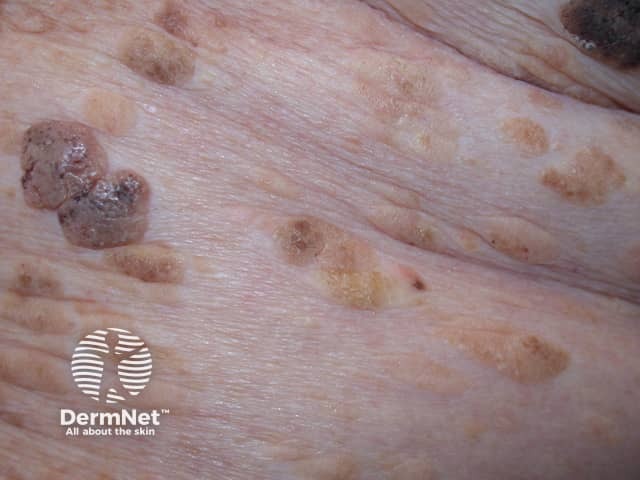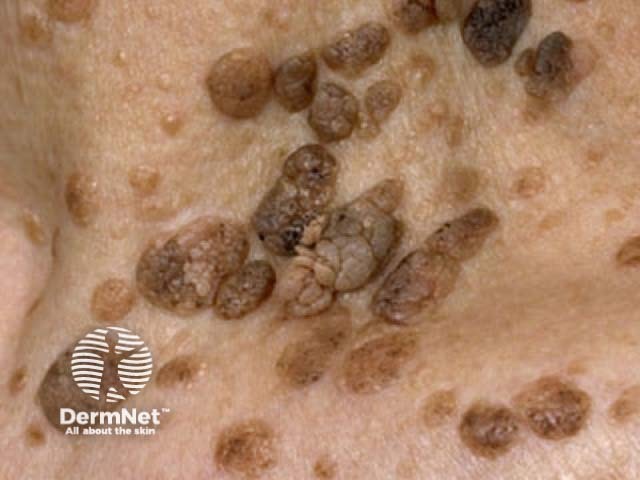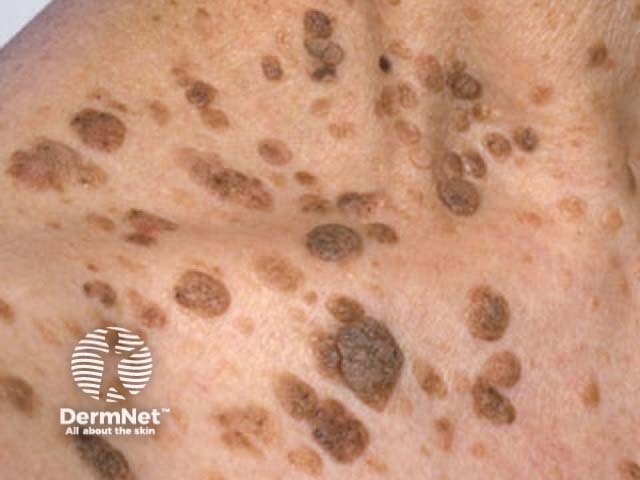Main menu
Common skin conditions

NEWS
Join DermNet PRO
Read more
Quick links
Sign of Leser-Trélat — extra information
What is the sign of Leser-Trélat?
The sign of Leser-Trélat is a skin disorder characterised by the abrupt appearance of multiple seborrhoeic keratoses that rapidly increase in their size and number. It is caused by an associated cancer and often occurs with malignant acanthosis nigricans.
Multiple eruptive seborrhoeic keratoses

Seborrhoeic keratoses

Seborrhoeic keratoses

Seborrhoeic keratoses
There is much debate about the validity of the sign of Leser-Trélat as a true paraneoplastic syndrome (skin disorder that arises from the remote effects of a primary tumour or its metastases). Because seborrhoeic keratoses and cancer are both statistically more common in elderly people it is difficult to ascertain whether the keratoses is due to the cancer (ie: a sign of Leser-Trélat) or is a condition in its own right. However, the sudden eruption of seborrhoeic keratoses in young patients points to a paraneoplastic process and should prompt an investigation for a hidden cancer.
What causes the sign of Leser-Trélat?
The cause of the sign of Leser-Trélat is unknown. It may possibly be due to the same unknown factors that induce malignant acanthosis nigricans. It is thought that paraneoplastic syndromes are caused by the release of hormones from the tumour but this remains to be proven.
The sign of Leser-Trélat has been linked to a variety of cancers but is mostly associated with an adenocarcinoma of the stomach or colon. Other cancers where the condition has occurred include squamous cell carcinoma, lymphoma and leukaemia. The sign of Leser-Trélat is rare, even among patients with cancer.
What are the features of the sign of Leser-Trélat?
The lesions originating from the sign of Leser-Trélat are the same as those found in eruptive seborrhoeic keratoses. They appear as brown warty nodules with a stuck-on appearance. The key indicators to determining a diagnosis of the sign of Leser-Trélat include:
- The sudden development of seborrhoeic keratoses that increase in size and number over a short period of time.
- Accompanying signs and symptoms of malignant acanthosis nigricans (occurs in as many as 35% of cases)
- Appearance of eruptive seborrhoeic keratoses in individuals aged less than 30 years
Pruritus (itching) may be the only symptom of the sign of Leser-Trélat and occurs in almost one half of patients.
What is the treatment for the Sign of Leser-Trélat?
Lesions of the Sign of Leser-Trélat are harmless and do not require specific treatment. The primary aim of treatment is to treat the underlying cancer. Lesions tend to resolve once the underlying cancer is treated. If necessary, lesions can be removed using various surgical procedures.
Similar to malignant acanthosis nigricans, the prognosis for patients with the sign of Leser-Trélat is often poor. The associated cancer is often advanced and the average survival of these patients is approximately 10.6 months.
On DermNet
- Cutaneous markers of internal malignancy
- Skin manifestations of gastrointestinal disease
- Skin pigmentation
- Seborrhoeic keratoses
- Acanthosis nigricans
- Florid cutaneous papillomatosis
Other websites
- Medscape Reference
